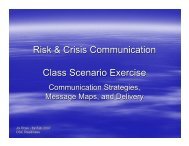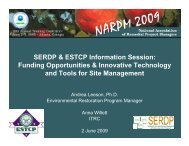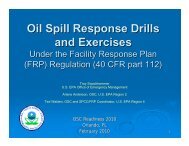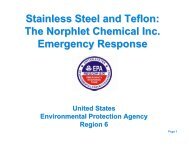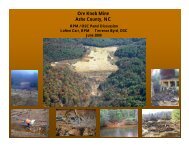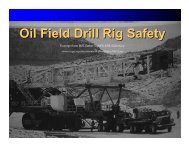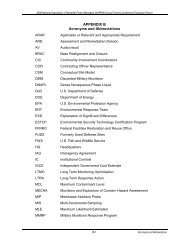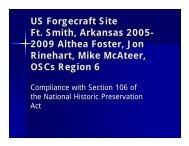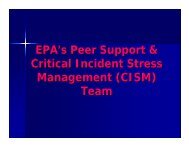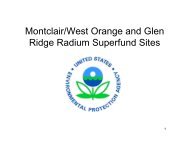04 Agroterrorism - Canzler r3.pdf
04 Agroterrorism - Canzler r3.pdf
04 Agroterrorism - Canzler r3.pdf
Create successful ePaper yourself
Turn your PDF publications into a flip-book with our unique Google optimized e-Paper software.
2007 OSC Readiness Training Program<br />
Then and Now<br />
Disposal Decision Making:<br />
<strong>Agroterrorism</strong>, the Avian<br />
Flu, and the OSC<br />
Erica <strong>Canzler</strong><br />
EPA/OEM<br />
Training by OSCs for OSCs • February 12-16, 2007 • Miami, Florida
<strong>Agroterrorism</strong><br />
• Agriculture has several characteristics that pose unique<br />
problems:<br />
• Agriculture production is geographically disbursed<br />
• Livestock are frequently concentrated in confined locations,<br />
and then transported and commingled with other herds<br />
• Pest and disease outbreaks can quickly halt economically<br />
important exports<br />
• Many veterinarians lack experience with foreign animal<br />
diseases that are resilient and endemic in foreign countries<br />
• Agents are easy to obtain; anonymous attack<br />
• Events such as FMD, 9/11,anthrax have changed the<br />
response structure of the federal government to include<br />
more coordination and integration
What’s at stake<br />
• $1.2 Trillion in economic<br />
activity (2002)<br />
• 2.8 Million workers (1994)<br />
• Exports are our lifeblood<br />
• $56.2 billion exported in Ag<br />
commodities (2003)<br />
• US Share of global<br />
production (2002)<br />
• 39% of corn<br />
• 38% of soybeans<br />
• 8% of wheat
Response Resources<br />
• Political<br />
• NRP<br />
• CONOPS for Decon/Disposal<br />
• Decon Portfolio<br />
• Tactical<br />
• Support Teams<br />
• Laboratories<br />
• Quick Reference Guides<br />
• National Stockpiles<br />
• SNS and NVS
Potential Livestock BW Agents<br />
• Avian influenza<br />
• Foot and mouth<br />
disease<br />
• Exotic Newcastle<br />
• Bovine spongiform<br />
encephalopathy<br />
• Anthrax<br />
• Classical swine fever<br />
• Rift Valley fever<br />
• Nipah/Hendra virus
Avian flu<br />
• Avian influenza viruses occur naturally in birds<br />
• All avian flu viruses are endemic in waterfowl &<br />
do not harm them<br />
• Among birds these viruses are very contagious<br />
and spread readily to domesticated birds<br />
including chickens, ducks and turkeys, causing<br />
severe illness and death<br />
• Virus is shed in saliva, nasal secretions, and<br />
feces—infection occurs by contact with these
Epidemiology of Avian Flu in<br />
Humans<br />
• Wild birds mix with<br />
domestic chickens in<br />
back yard farms<br />
• Domestic chicken<br />
flocks mix in live<br />
poultry markets<br />
• People mix with sick<br />
or dead chickens<br />
• People catch avian flu
How Spread…<br />
Among People<br />
• Nearly all cases have involved people coming in<br />
direct contact with infected feces or secretions<br />
• One Indonesian family with 7 victims recently got<br />
people worried, but there is no evidence to date that<br />
this represents any change in the usual pattern of<br />
spread<br />
• Among Birds<br />
• Anticipated spread by migratory birds to Alaska from<br />
Asia via the East Asia/Australian flyway has not<br />
materialized
Major AI Outbreaks – Domestic Poultry<br />
Year<br />
Subtype<br />
Location<br />
Impact<br />
Notes<br />
1983<br />
H5<br />
PA, USA<br />
Affected chickens, turkeys,<br />
guinea fowl 1.7 mill. birds culled<br />
Mild virus circulating for 6<br />
mo. in the area – no human<br />
cases<br />
1994-2003<br />
H5N2<br />
Mexico<br />
1 billion birds affected<br />
LPAI mutated HPAI<br />
outbreak ’94-5. Strain has<br />
circulated since. No human<br />
cases.<br />
1995-2003<br />
H7N3<br />
Pakistan<br />
3.2 mill. birds died in initial<br />
outbreak 1995<br />
Vaccination campaign ended<br />
outbreak. No human cases.<br />
1997<br />
H5N1<br />
Hong Kong<br />
Virus isolated from chickens; 1.5<br />
mill. birds culled in 3 days<br />
18 human cases/6 deaths.<br />
First H5N1 human infections<br />
2003<br />
H7N7<br />
Netherlands<br />
30 /100 mill. birds in country<br />
killed; 255 flocks infected.<br />
Spread to Belgium rapidly<br />
contained<br />
80 human cases, 1 vet. died.<br />
Most cases involved conjunctivitis<br />
(“pink eye”)<br />
2003-2006<br />
H5N1<br />
Asia, Europe, Africa<br />
Most severe outbreak to date;<br />
220 mill. birds died or culled – is<br />
ongoing<br />
>250 human cases, >50% fatal<br />
in 10 countries<br />
20<strong>04</strong><br />
H7N3<br />
British Columbia<br />
>19 mill. birds culled<br />
2 human cases, both with<br />
conjunctivitis<br />
2005<br />
H7<br />
North Korea<br />
200,000 birds culled as of 4/05<br />
No human cases.
EPA Bird-Brained -or-<br />
EPA—Keep Your Eye on the Birdie!<br />
• So where’s the beef What’s avian flu got to do<br />
with an OSC in the EPA<br />
• Research is showing that H5N1 can persist for<br />
months in the environment under the right<br />
conditions<br />
• The language of HSPD 9 leaves open the possibility<br />
that if a non-agricultural setting were contaminated<br />
in an outbreak that EPA could be asked to perform<br />
disinfection/decontamination for AI
HSPD 9 –Roles and<br />
Responsibilities<br />
• ESF Annex #11 establishes USDA as the<br />
primary Federal agency to respond to animal<br />
disease outbreaks in an agricultural setting<br />
• ESF Annex #8 establishes HHS/FDA as the<br />
primary Federal agency to respond if the<br />
disease agent is identified as a zoonosis<br />
• ESF Annex #10 establishes EPA as the primary<br />
Federal agency to respond if there is chemical<br />
contamination or persistent biological<br />
contamination that poses an imminent and<br />
substantial threat to public health and/or the<br />
environment
HSPD 9 – Roles and<br />
Responsibilities<br />
• Disposal of animal carcasses in animal disease<br />
outbreaks is the responsibility of USDA in<br />
cooperation with local and state authorities<br />
• EPA solid waste, air and water expertise can be<br />
consulted<br />
• If local/state and USDA resources are<br />
overwhelmed, additional resources are<br />
available through the NRP in accordance with<br />
ESF Annex #11<br />
• As the response grows in INS (level 3), EPA OSCs<br />
may be called upon to work in the Disposal Unit
Response Structure<br />
• Unified Command – probably APHIS in<br />
conjunction with State Department of<br />
Agriculture<br />
• Depends on location and actual nature of event<br />
• Pre-determined plans; disposal sites<br />
• In-house composting = preferred (volume &<br />
species)<br />
• State Vet assists in response<br />
• Local resource support to the maximum extent<br />
possible
Avian Flu Carcass Disposal<br />
• Common Methods<br />
• Composting<br />
• Burial<br />
• Incineration<br />
• Rendering<br />
• Isolation<br />
• Disposal of Domestic Birds Infected by Avian Influenza<br />
• EPA530-R-06-009<br />
• USDA prefers on-site management (composting)
Foot and Mouth Disease
Worker Health and Safety
Carcass Handling
Location
Avian Flu –<br />
Disinfection/Decontamination<br />
• Chemical methods<br />
• Most detergents<br />
• Most disinfectants<br />
• Physical methods<br />
• Heating (the higher the temperature, the more rapid<br />
the inactivation)<br />
• Complete drying<br />
• Disinfection of the environment is usually done<br />
by a chemical method
Avian Flu Decontamination<br />
• List of 90 agents registered with EPA with<br />
label claims of being effective against<br />
H5N1<br />
• http://www.epa.gov/opp00001/factsheets/avi<br />
an_flu_products.htm<br />
• None officially approved by EPA for this use<br />
• Decon. of avian flu would therefore require a<br />
FIFRA Section 18 emergency exemption
Avian Flu – Responder Health<br />
and Safety<br />
• Observe basic infection control measures after<br />
• Contact with infected or exposed poultry<br />
• Contact with surfaces contaminated with bird feces<br />
or secretions<br />
• Removing PPE of any kind<br />
• Good hand hygiene includes<br />
• Hand-washing with soap and water for 15-20<br />
seconds<br />
• If hand-washing facilities not available, use<br />
accepted alternative means (e.g. waterless alcoholbased<br />
hand-cleaning gels)
Avian Flu – Responder Health<br />
and Safety<br />
• Antiviral medications<br />
• CDC recommends influenza antiviral medication for<br />
any worker who has direct contact with infected<br />
fowl, their feces or excretions<br />
• Medical monitoring<br />
• Exposed workers should be watched carefully for the<br />
development of typical influenza symptoms:<br />
• Fever, sore throat, cough, muscle aches, diarrhea,<br />
trouble breathing<br />
• If signs of illness develop, worker to notify healthcare<br />
provider, occ. med. and infection control personnel at their<br />
workplace<br />
• Other than visiting healthcare provider, should stay at<br />
home until 24 hours after fever resolves
Conclusion<br />
• Whether animal death occurs naturally, by a<br />
FAD outbreak, or even by a terrorist<br />
attack…proper planning will make all the<br />
difference<br />
• Build the toolbox (methods of decon/disposal)<br />
• Know the PPE needed - safety first<br />
• The quicker the response to eradicate the<br />
disease, dispose of infected carcasses, and<br />
decontaminate…the lower the impact on<br />
agricultural operations



